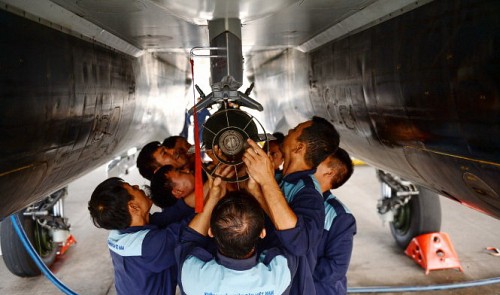The committed caretakers in charge of Vietnam’s Russian-made Su-30MK2 fighter jets go to great lengths to make sure the ‘cobras’ are airworthy and ready to strike at any moment.
They are the seasoned engineers and technicians at the 935 Fighter Jet Regiment, stationed in Bien Hoa City in Dong Nai Province, some 30 kilometers from Ho Chi Minh City.
They are entrusted with the exacting routine of ensuring the Su-30MK2 fighters, a state-of-the-art supersonic military aircraft likened to a master cobra in the air, are flight-ready by 6:00 am.
To do so, they must start their day’s work at 3:30 am, before the sun is even up.
Each warplane is tended to by a technical team in different disciplines, including fighter jets, aviation equipment, weaponry, and e-combat.
Head engineers oversee three fighter jets each.
As the first unit of the Air Force-Air Defense of Vietnam to be armed with an all-Su-30MK2 fleet, the 935 Fighter Jet Regiment takes great pride in its over 100 exceptional technical staffers.
In charge are two young men, Captain Nguyen Dinh Binh, 33, head of Company 2, and Captain Tran Trung Thang, 31, head of Company 1.
The duo take the helm of a colossal state asset, as each Su-30MK2 jet costs approximately US$60 million plus the exorbitant prices of its accompanying weaponry.
At 5:40 am on a training day, two chief technicians were already inside the cockpit, making sure the craft was ready before pilots embarked on their weather reconnaissance flight in order not to waste time.
As a rule, only chief technicians are allowed into the cockpit.
They also helped the pilots fasten their seatbelts, put on their helmets and plug in the breathing apparatus.
They then signaled for the ‘King Cobra’ to move out of the hangar and soar into the sky.
The technical staff dashed to the warplane as soon as it returned from its flight to provide checkups and ask the pilots about its condition.
“Our utmost daily concern is how Su jets [Su-30MK2 fighters’ nickname] operate during each flight. We always make the best possible preparation to ensure they are airworthy and never allow human error,” chief technician Nguyen Si Phong said.
Being the first to arrive at the airport at dawn, the technical staff are also the last to leave in the afternoon.
Mechanics with peerless skills The first unit to tap into Su-30MK2 fighter jets, the 935 Fighter Jet Regiment’s technical staff pride themselves on their unrivalled expertise across the Air Force-Air Defense of Vietnam.
According to Senior Lieutenant Colonel Le Van Hoi, the regiment’s technical crew members have been tasked with providing technical training for their counterparts in other air force divisions over recent years.
Meanwhile, the jet engine workshop, which is the regiment’s heart, where all the repair work is carried out, is also home to highly skilled technicians and innovators.
Many of them have been enthusiastically lauded by Russian experts for innovatively fixing routine technical errors unique to Vietnam due to weather and climatic conditions.
Major Mai Doan Chinh, considered by colleagues to be a ‘live dictionary’ thanks to his profound knowledge of the Su-30MK2, learned Russian on his own and now excels as an interpreter and book translator in the language though he has never been to the European country.
His keenness to learn and incomparable mental retention power are highly revered.
Nguyen Van Long, chief technician and a ‘golden hand,’ graduated with a middle-ranking diploma but can rectify the most challenging errors by teaching himself.
Long, trusted with heading the fighter jet platoon, can describe details as minute as screws and can detect what is wrong with the jets just by listening to their engines’ sounds.
He is the first official at the air base who can smooth metal sheets in the air compression unit in the planes’ engines, which saves hundreds of thousands of U.S. dollars and considerable time if the broken pieces are sent to Ministry of Defense factories or to Russia for repair.
With initiative and commitment, some others have also invented devices to repair Su-30MK2 fighters’ cockpit covers and a net to prevent birds from entering the engine and damaging compression sheets.
Previously, the regiment had used old tools to perform checks on missile electric circuits.
Major Nguyen Tien Long, an aviation weaponry assistant, researched and successfully tried out new tools which boast maximal accuracy and save more than two thirds of the time needed.
First Lieutenant Tran Gia Chuan invented a machine to check the ejection seat’s electrical system.
Senior Lieutenant Colonel Le Van Tang devised an apparatus to test the ‘King Cobra’’s electronic light radar system.
“We always make sure our work is performed timely and precisely, as our work means a life-and-death difference to pilots’ lives,” said Lieutenant Colonel Dang Xuan Vy, head of the technical battalion, who had devised a gadget to disassemble compression sheets.























































